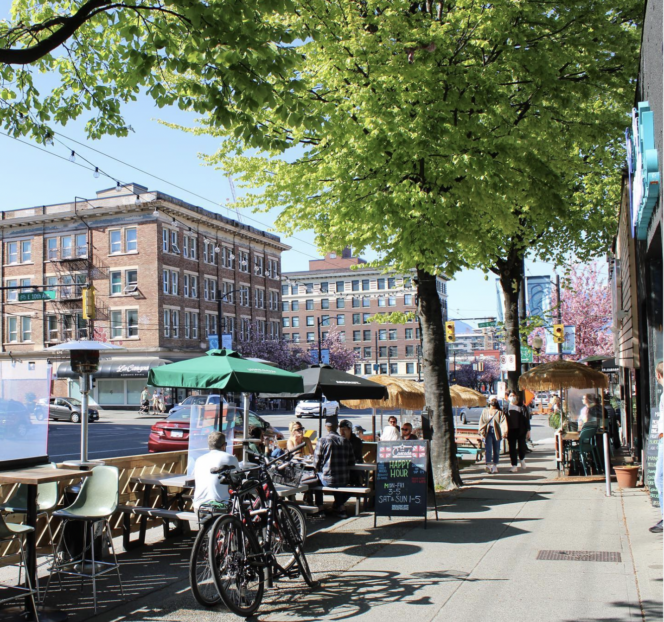
Photo: Mount Pleasant BIA
While in the last decade, Mount Pleasant has become an exciting hub for restaurants, breweries, and shopping boutiques, this popular Vancouver neighbourhood has a fascinating history—one that is well worth preserving.
Neil Wyles, Executive Director of the Mount Pleasant Business Improvement Area (MPBIA), loves Mount Pleasant for its mix of old and new: it has considerable heritage architecture, but also many new buildings, which have brought an influx of new residents. “There are a bunch of interesting established businesses and cool restaurants and cafes that make the neighbourhood very interesting, and I think it’s worth drawing people to it,” he says.
The neighbourhood, which has Cambie Street and Clark Drive as its west/east borders and False Creek and 16th Avenue as its north/south borders, is located on the traditional, ancestral, and unceded territory of the Musqueam, Squamish, and Tsleil-Waututh peoples. It has a long history with Indigenous peoples who originally lived on its land. The rich environment had an abundance of flora and fauna, including deer, elk, salmon, berry bushes, and Labrador tea plants. The land featured rainforest, as well as swamp caused by a sizeable beaver dam.
The start of the Gold Rush in 1858 brought in people looking to strike it rich, boosting activity. The area also attracted the attention of developers and businesses, including Henry Valentine Edmonds, who gained the rights to part of the land (District Lot 200A) in 1869, as well as Hastings Sawmill, who used the trees in the area for timber. Edmonds named the area “Mount Pleasant” after a village in Ireland where his wife hailed from. Dominating the area was a creek (parallel to today’s Main Street), which became known as Brewery Creek due to the many breweries that made use of the water.
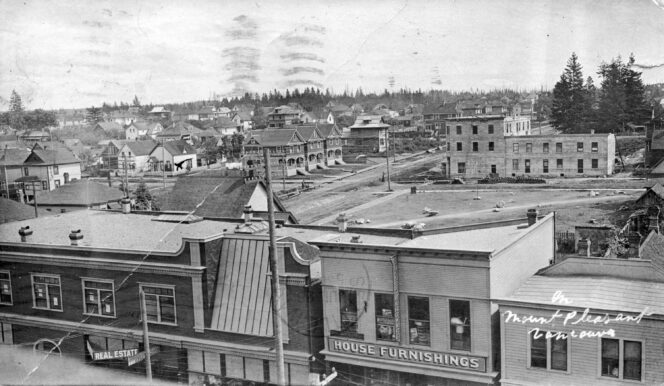
On Mount Pleasant Vancouver (1907); Photograph shows the southeast view from Westminster Avenue (Main Street) and 10th Avenue including the Temperance Hall; City of Vancouver Archives
In 1889, Vancouver’s streetcar system accelerated the growth of Mount Pleasant by connecting it to the rest of the city. Mount Pleasant became the first suburb outside of the downtown core. Wyles says Centrepoint Mall (2949 Main Street) used to be the location of the old streetcar barn. “You came out of downtown, and you were taking this big voyage to the outskirts of the city—the outskirts of Mount Pleasant,” he says. Remnants of the old street car lines can still be found along Quebec Street. With the construction of the Broadway Subway Project, which will extend the Millennium Line from VCC-Clark Station to Broadway and Arbutus, Mount Pleasant will be part of significant transportation infrastructure. “History is repeating itself, and Mount Pleasant will again be connected to the rest of the city via mass transit,” Wyles says.
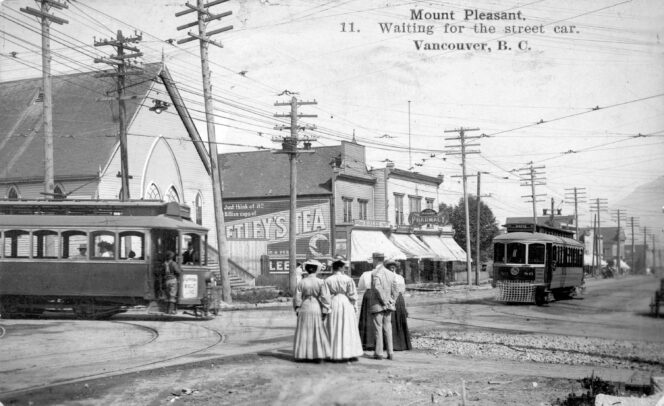
Mount Pleasant, waiting for the street car (1908), Vancouver, B.C.; City of Vancouver Archives
The 1930s to the 1960s saw a considerable decline due to industrialization in the area but waves of rejuvenation have added new life to Mount Pleasant. A turning point was the establishment in 1989 of the MPBIA, which was the first BIA in British Columbia. For those unfamiliar as to what a BIA does, Wyles likens himself to a giant shopping mall manager. In other words, he manages the ‘shopping mall’ of Mount Pleasant in terms of security, safety, and cleanliness. Through funding from its members, the MPBIA also keeps Mount Pleasant beautiful, organizes special events, fosters its economic vitality, markets and promotes the area (e.g., on social media), and serves as the communicational go-between when it comes to the City and other relevant organizations. For example, during COVID, much of the MPBIA’s work involved helping members navigate public health regulations.
In the five years since Wyles has been Executive Director, he has seen a lot of positive changes and growth in Mount Pleasant. When he started his job, there were 20 construction cranes in the sky in the area—with many of these projects now completed. He says there is a need to maintain the unique character of Mount Pleasant. “At a certain point, we don’t want to do too much more because then we’re going to start to knock down things that are needed or interesting, or that still have plenty of life left in them,” he says. Part of what makes Mount Pleasant special is its heritage, and the independent vibe of its many businesses.
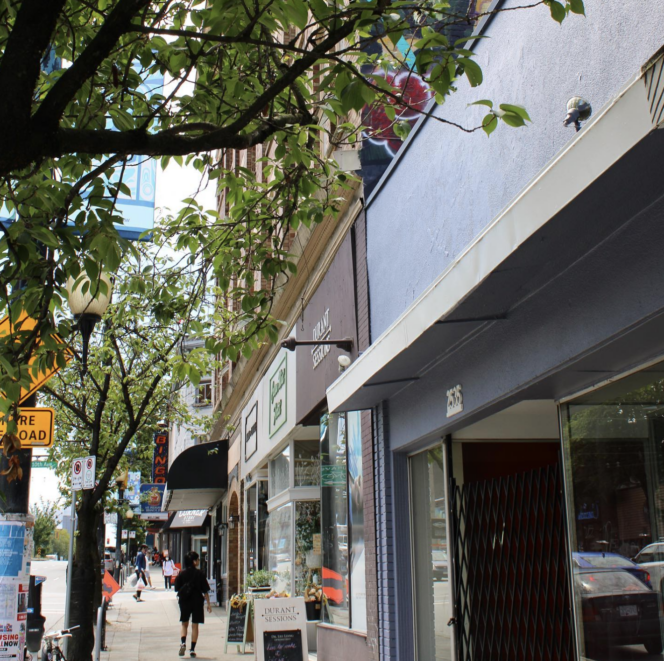
Photo: Mount Pleasant BIA
Wyles, however, says that preservation is not within the MPBIA’s control. Mount Pleasant has some gorgeous heritage architecture. He mentions the stone and brick building where Cash Money is now located (2490 Main Street), which was designed by the architects J.J. Honeyman and George Curtis and built in 1929 for the Bank of Montreal. “It’s a beautiful little building. It’s one of those old school, turn-of-the-century limestone bank buildings,” he says. Other buildings are protected by a municipal heritage designation bylaw, such as Heritage Hall (3102 Main Street), which was completed as Postal Station C in 1916, with a clock tower built in 1915. Wyles says that there are many places in Mount Pleasant that need preserving.
Many of the businesses and organizations in the neighbourhood have also been around for a very long time. Brownie’s Florist (273 East Broadway) is one of the longest running businesses at roughly 70 years. Other neighbourhood fixtures include the Royal Canadian Legion Branch 177; the stores along Main Street’s Antique Row; the Goh Ballet Academy (2345 Main Street), which is housed in a neoclassical revival building constructed in 1912; and Mount Pleasant Optometry Centre (104 East Broadway), which first opened in 1950. Even unassuming Kingsgate Mall (370 East Broadway), which is often subject to affectionate joking, has become a Mount Pleasant institution.
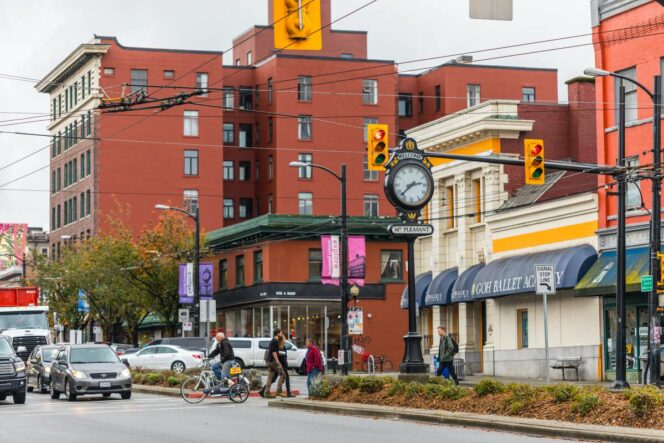
Main Street Mount Pleasant; Destination Vancouver/Nelson Mouellic
While Mount Pleasant has a rich past, its present and future are also equally exciting. Wyles is looking forward to the return of free outdoor entertainment in the neighbourhood. This summer, residents and visitors to Mount Pleasant can look forward to a variety of programming, including events for the Vancouver International Jazz Festival, Car Free Day, the Vancouver Mural Festival, and a heritage hunt put on by the Vancouver Heritage Foundation. Stay tuned for details about each of these events (and more).
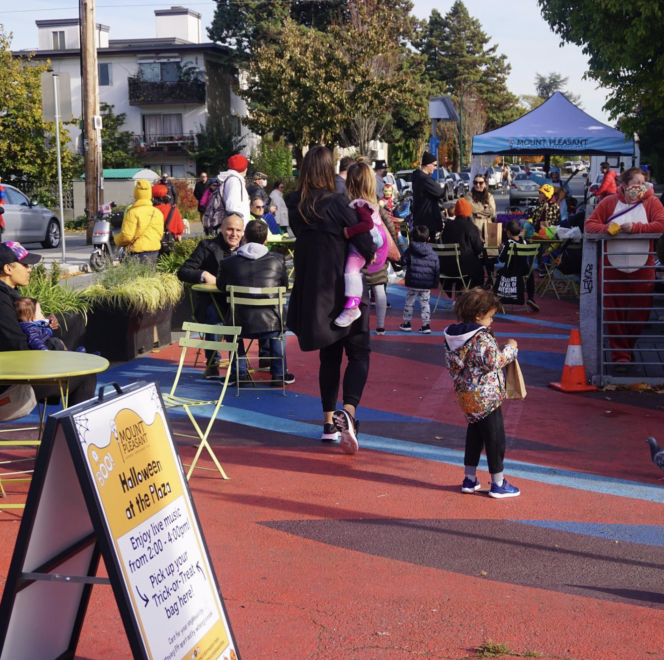
Photo: Mount Pleasant BIA
There will be a return of many of the street-side patios that made Mount Pleasant so bustling last summer. In 2021, there were roughly 50 in the neighbourhood, with many slated to return this year.
Wyles says there are so many reasons to visit Mount Pleasant besides the summer programming. If you’re not able to make the Vancouver Mural Festival, you can still tour all the colourful and creative murals when you visit another time. The area is home to roughly 160 murals (download the Mural Festival app to locate all of them), which have become part of the landscape of the streets and alleys. “There is a lot of public art here, and well worth the price of a bus ticket to come to Mount Pleasant,” he says.
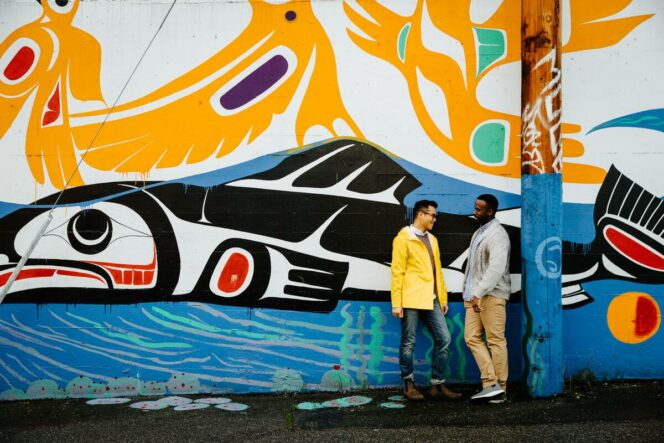
Men talking in front of mural in Mount Pleasant; Destination Vancouver/Hubert Kang
While Brewery Creek no longer exists, the area has stayed true to its brewery roots. “Main Street Brewing is on the site of the original brewery. The building still exists, and it’s still a brewery,” Wyles says. Craft beer enthusiasts can visit the many other breweries as well, such as 33 Acres Brewing Company and Brassneck Brewery, all within walking distance of one another. “There’s some really interesting stuff that these breweries are putting in their glasses right now. They’ve won all kinds of awards for it,” Wyles says.
Wyles is really proud of the quality of the food scene in Mount Pleasant. “As things become more expensive to operate places downtown, they’re moving just outside of the downtown core,” he says. Some of his suggestions include the new Zarak by Afghan Kitchen (2102 Main Street); Burdock & Co. (2702 Main Street), run by award winning chef Andrea Carlson; Savio Volpe (615 Kingsway) for stellar rustic Italian cuisine; Les Faux Bourgeois (663 East 15thAvenue) for French bistro classics; Published on Main (3593 Main Street), for elevated locally-sourced plates; and Thierry (265 East 10th Avenue) for chocolates, café beverages, and pastries. He’s also excited about the soon-to-open Farmhouse (352 East 10th Avenue), a farm-to-table restaurant run by the Viaggio Hospitality Group (e.g., Ancora).
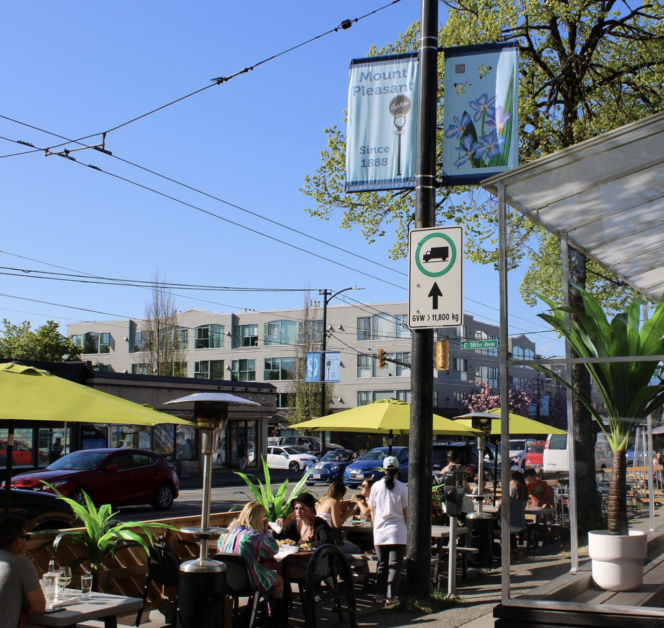
Photo: Mount Pleasant BIA
“And definitely the cocktail culture is alive and well in Mount Pleasant,” Wyles says, who suggests visiting The Cascade Room (2616 Main Street) or Tocador (2610 Main Street) for a drink. Clearly, based on all these recommendations, there’s no shortage of things to do and see in charming and historic Mount Pleasant.

















One Response to Celebrating the Unique Vibrant Character of Vancouver’s Mount Pleasant